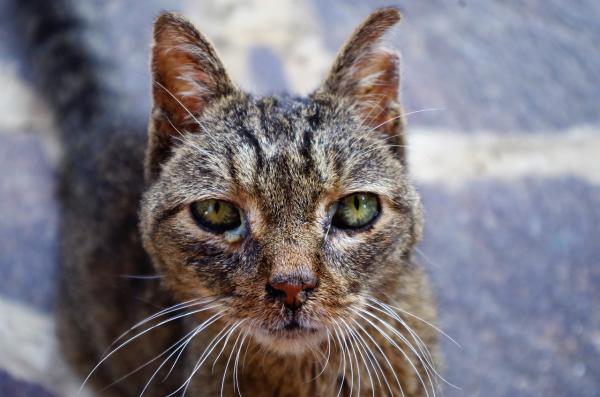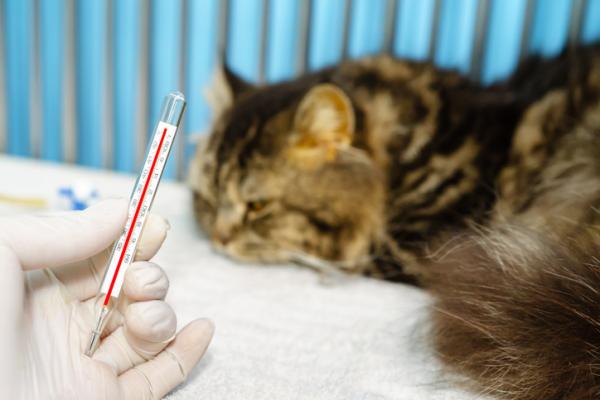Rhinitis in cats – Causes, symptoms and treatment

The rhinitis in cats They are a relatively common disorder, often related to viruses that cause respiratory problems such as herpes virus or calicivirus. But, as we will see in this article, there are several causes behind rhinitis, to the point that it can be difficult to reach a diagnosis.
If we observe that our cat has a persistent nasal discharge we should go to our veterinarian, since he could be suffering from rhinitis and / or sinusitis. Keep reading and discover How to know if your cat has rhinitis and what to do.
Symptoms of rhinitis in cats
Rhinitis is a inflammation of the nasal cavity. The nasal region, which begins in the nostrils that we can observe from the outside, continues in the nasal cavity, which occupies what we see outside the snout, and extends connecting with the throat and the breasts. The inflammation of these is called sinusitis and is common in rhinitis, as well as other problems in the respiratory tract or ear, due to the connection that all these systems have.
The prominent symptoms of rhinitis are the nasal discharge and sneezing, but there may also be respiratory noises. The characteristics of the secretion can help us to establish the diagnosis.
Causes of rhinitis in cats
As we have said, the viral infections tend to be behind rhinitis. The viruses cause rhinitis and other symptoms such as ocular discharge, cough or anorexia. Further, the herpesviruses y the calicivirus remain in the body, even if the cat seems healthy and, in situations where there is a decrease in the defenses, it is easy for these viruses to return to produce symptoms, which can lead to a picture of chronic rhinitis in cats.
Immunodeficiency viruses y of leukemia Felines can also be involved in nasal infections. Another serious cause of rhinitis are the mushrooms as Cryptococcus, Responsable of fungal rhinitis in cats and that can also form granulomas. In these cases the nasal discharge can appear only through one of the orifices, as in the cases of polyps or tumors. The latter appear especially in cats older than ten years, and highlights the adenocarcinoma. Likewise, they can explain the appearance of rhinitis in which the secretion is unilateral and, sometimes, stained with blood. On the other hand, dental problems or oronasal fistulas They can also lead to feline rhinitis. It should be noted that when there is a growth, whether polyp, tumor or abscess, we may notice that the face of our cat is deformed.
Other causes of rhinitis in cats are allergies, the presence in the nasal cavity of strange bodies that cause irritation or trauma, such as falling from a great height or being run over. In addition, bacterial infections can complicate any of these situations, producing a purulent discharge.

How to diagnose rhinitis in cats?
If we observe that our cat presents nasal discharge that does not remit, we must go to the veterinarian. This secretion interferes with the cat’s sense of smell, which can lead to loss of interest in food, which will aggravate the picture. Finding the cause of rhinitis is not always easy and, sometimes, you have to perform crops to know before what type of infection we are, rhinoscopy, to see the state of the nasal cavity and detect the presence of polyps, tumors or foreign bodies, as well as to take samples, or radiographs that allow assessing bone structures.
For complicated cases, recourse is had to the MRI or CT scan, which allows to examine the breasts. If the cat has more symptoms such as anorexia or decay, it is advisable to perform a blood test to have information about their general condition and the possible presence of infections that can be diagnosed with specific tests.

How to cure rhinitis in cats?
The treatment of rhinitis in cats will depend on the cause:
- If we are facing a bacterial infection The veterinarian will prescribe antibiotics, broad spectrum or specific if we have done culture.
- If the Rhinitis is caused by fungi, the treatment of choice will be antifungal. In both cases they should be administered for weeks.
- Polyps may require surgery, just as if we are dealing with a tumor, which can also be treated with chemo or radiotherapy.
- En dental problems the extraction of the affected parts is usually necessary.
- In viral cases, which are going to be very numerous, stimulators of the immune system could be tested. Antibiotics are also prescribed to control secondary bacterial infections.
We must know that Rhinitis can become chronic, case in which the treatment will be oriented to treat the symptomatology so that the cat has a good quality of life. For all this, self-medicating the cat is never a good idea, since the administration of an inappropriate drug can seriously worsen the animal’s condition.
This article is merely informative, in .com we do not have the faculty to prescribe veterinary treatments or make any kind of diagnosis. We invite you to take your pet to the veterinarian in case of any type of condition or discomfort.
If you want to read more articles similar to Rhinitis in cats – Causes, symptoms and treatment, we recommend that you enter in our section of respiratory diseases.


